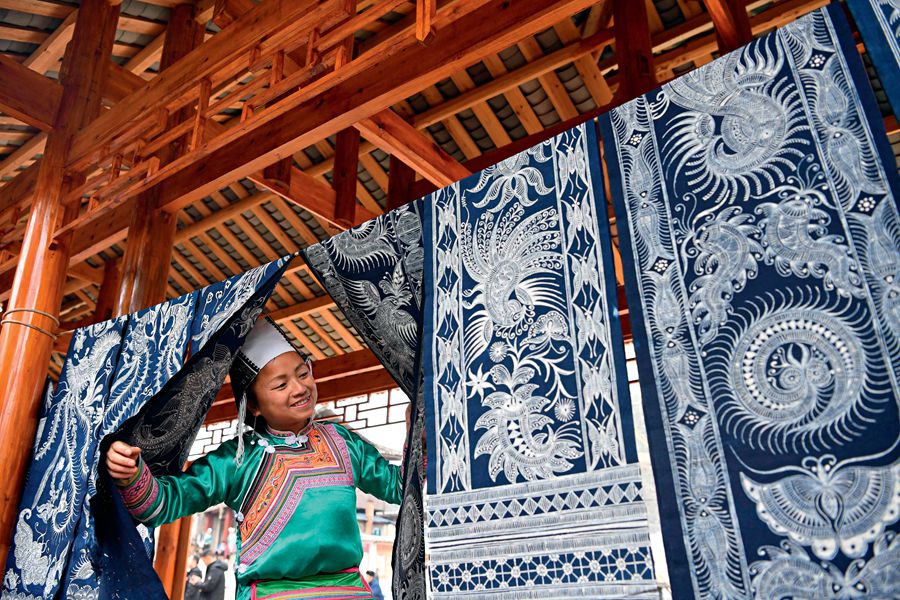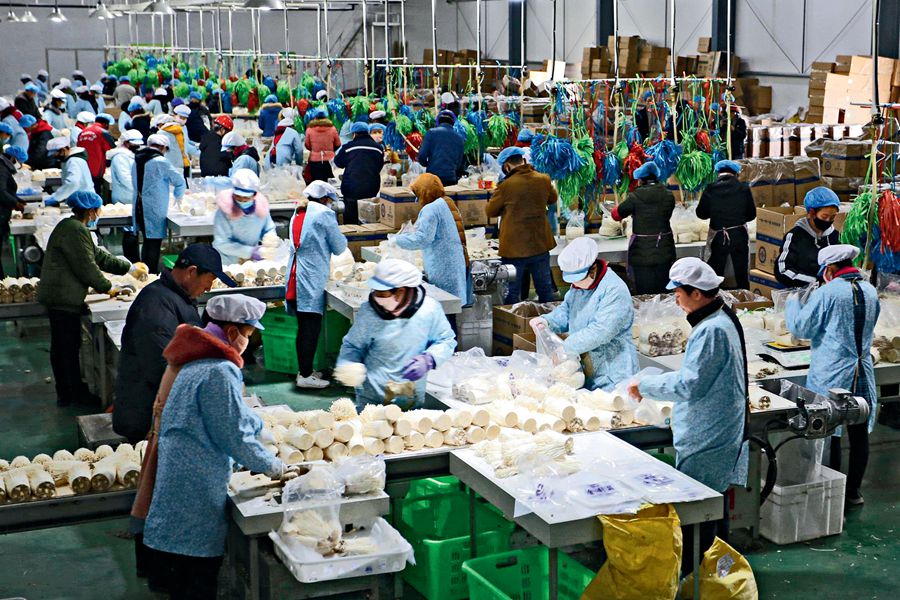A total of 13.86 million rural poor were raised out of poverty, and 2.8 million people living in remote areas, areas frequently hit by natural disasters, or areas with fragile ecosystems were relocated and are living well-off lives in 2018, said Premier Li Keqiang in the Report on the Work of the Government he delivered on March 5.
According to the latest statistics released by the National Bureau of Statistics (NBS), as of the end of 2018, the rural impoverished population in China was 16.6 million, and the incidence of poverty was 1.7 percent, 1.4 percentage points lower than that of the year before.
New Progress, New Achievements
In 2018, under the guidance of President Xi Jinping’s expositions on poverty alleviation, various divisions throughout China implemented targeted measures on poverty alleviation and promoted the poverty alleviation process. The targeted measures have been enforced thoroughly, and the effect continues to bring new progress and achievements in China’s poverty alleviation strategy in the new era.

On January 23, 2019, a woman of Miao ethnic group inspects batik products in Gaoniao Village, Rongjiang County in Guizhou Province.
Since the 18th National Congress of the Communist Party of China (CPC), the number of rural poor has decreased by 82.39 million. By the end of 2018, the poverty-stricken population in the countryside had decreased from 98.99 million at the end of 2012 to 16.6 million, a total reduction of 82.39 million. The incidence of poverty had dropped from 10.2 percent in 2012 to 1.7 percent, a total decrease of 8.5 percentage points.
The growth rate of per capita disposable income of rural residents in poverty-stricken regions continues to be higher than that in rural areas throughout the country. In 2018, the per capita disposable income of rural residents in poverty-stricken areas was RMB 10,371 (US $1,548), an increase of RMB 994 (US $148) over the previous year, a nominal increase of 10.6 percent, and an actual increase of 8.3 percent after deducting the price factor. The real growth rate was 1.7 percentage points higher than the average growth rate in rural areas. The growth rate continues to surpass that of the whole country.
The income of rural residents in poverty-stricken areas has increased by 10 percent annually since the 18th CPC National Congress. From 2013 to 2018, the per capita disposable income of rural residents in poverty-stricken areas rose by 12.1 percent in nominal terms, an actual increase of 10 percent after deducting the price factor. The real growth rate was 2.3 percentage points higher than the national average. In 2018, the per capita disposable income of rural residents in poverty-stricken areas was equivalent to 71 percent of the national average rural level, 8.9 percentage points higher than that in 2012. The gap with the national average rural level was further narrowed.
The fundamental cause for the remarkable success of poverty alleviation lies in targeted policies and measures for poverty alleviation implemented throughout the country. In 2018, the major policies and measures adopted by various departments in different regions to promote poverty alleviation include:
First, top-level design was improved. The CPC Central Committee and the State Council issued the Guiding Opinions on the Three-Year Action to Win the Fight against Poverty. The General Office of the CPC Central Committee and the General Office of the State Council issued a work plan and assigned 128 tasks to 71 departments. Later on, policies and measures were strengthened, and organizational leadership was intensified. Various departments promulgated support policies to enhance the implementation. Twenty- two provinces, autonomous regions and prefectural cities in central and western China have formulated three-year implementation plans.

On January 12, 2019, workers in the packaging workshop of Zhongxing Mushroom Industry in Wuwei, Gansu Province, are packing enoki mushrooms.
Second, there was focus on poverty alleviation, especially in regions plagued by dire poverty. Areas where people live in dire poverty were taken as the focus where resources were concentrated.
The focus was set on state-level impoverished regions in Tibet Autonomous Region, Xinjiang Uygur Autonomous Region, and provinces of Gansu, Sichuan and Yunnan. A total of 135 counties and over 8,700 villages were identified as extremely impoverished places in Tibet Autonomous Region, four prefectures in south Xinjiang, the Tibetan-inhabited areas in four provinces, Linxia Hui Autonomous Prefecture in Gansu Province, Liangshan Yi Autonomous Prefecture in Sichuan Province and Nujiang Lisu Autonomous Prefecture in Yunnan Province. In the rest of the regions, another 199 counties and some 21,000 villages were recognized.
Varied departments across the nation have increased their support in terms of policy, funding, and projects to these areas in an effort to create jobs by developing industries and improve local infrastructure and public services.
The third was to promote poverty alleviation cooperation between eastern and western regions and counterpart support program in respect of poverty reduction. The first assessment on the performance of relevant departments was organized and implemented 21 years after the implementation of the cooperation in poverty alleviation between eastern and western regions and 31 years after agencies and organizations under central authorities began the program of counterpart support in respect of poverty reduction. Eastern and western provinces and municipalities signed cooperation agreements on poverty alleviation, and agencies and organizations under central authorities signed letters of commitment. Remarkable outcomes have been achieved as private businesses, social organizations and individual citizens actively get involved in poverty alleviation efforts.
The fourth was to implement targeted measures. The breeding industry in poverty-stricken areas has developed rapidly. By boosting e-commerce, photovoltaic industries, rural tourism and others, many people have been lifted out of poverty. Targeted measures like relocating the poor, offering them jobs and education support, developing ecological protection projects, and improving the infrastructure and power grids in poor areas have generated tangible benefits for local people.
The fifth was to continue to increase investment in poverty alleviation. The central and provincial governments have earmarked more than RMB 300 billion for poverty alleviation. More than RMB 320 billion in special funding for agriculture has been channeled to poor counties. The microloans for poverty alleviation have increased by RMB 100 billion, adding the accumulative total to RMB 530 billion. The support from the capital market and insurance sector has been intensified. The supervision of funding for poverty alleviation projects has been strengthened.
In addition, more efforts have been made in terms of work style, training, and an assessment system, creating a favorable environment for winning the battle against poverty.
Challenges Ahead
In 2019, the fight against poverty has entered a decisive stage where a slew of challenges lay ahead.
First, it is very difficult to uplift people out of poverty in areas plagued by dire poverty. Poverty issues are still prominent in state-level impoverished regions in Tibet Autonomous Region, Xinjiang Uygur Autonomous Region, and provinces of Gansu, Sichuan, and Yunnan. More support should go to these regions.
Second, there are still poor people who have no adequate food or clothing, or access to nine-year compulsory education, basic medical services or safe housing. The lack of access to safe drinking water, high dropout rates from school, the lack of access to basic medical services in poor rural areas, and the problem of unsafe housing of poor households are still endemic in some areas.
Third, the long-term mechanism for getting rid of poverty needs to be steadily improved. Developing industries as a way to eradicate poverty aims at short-term outcomes in some regions, resulting in poor sales in the market. The industries failed to help poor people increase their income. Some areas didnot introduce supporting policies for relocating the poor people or creating jobs, while others paid inadequate attention to the problem that some people return to poverty because they did not make the needed precautions in dealing with natural disasters or illnesses. Besides, in some places, the assistance to poor households lacks sustainability, and stops before the poor are completely uplifted out of poverty.
Fourth, poverty alleviation efforts are not made in a targeted manner in some cases. In certain places, poverty alleviation work has been simplified, and efforts have not been focused on aiding poor villages and people.
New Countermeasures, New Moves
Winning the battle against poverty demands new countermeasures and new moves. This year marks the 70th anniversary of the founding of the People’s Republic of China, and is also a crucial year for building a moderately prosperous society in all respects, as well as a year for winning the battle against poverty.
Government departments around the country will thoroughly act upon the Xi Jinping Thought on Socialism with Chinese Characteristics for a New Era and the guiding principles of the 19th National Congress of the CPC. They will study and comprehend Xi’s expositions of poverty alleviation, and take a problem-oriented approach. They will prioritize regions trapped in dire poverty and vulnerable groups in tackling the poverty issue and deal with issues relating to providing poor people with adequate food and clothing as well as access to education, basic medical services, and safe housing. They will improve the accountability systems and the quality of poverty eradication to consolidate the achievements and prevent people from returning to poverty. In this way, they will ensure that about 10 million more rural poor people will be lifted out of poverty. The task of relocating poor people as set in the 13th Five-Year Plan (2016-2020) will be completed, laying a solid foundation for winning the battle against poverty in an all-round way by 2020.
They will take the following major measures. First, efforts will be focused on providing poor people with adequate food and clothing and access to education, basic medical services, and safe housing.
Second, a great effort will be made to tackle the key problems in regions where people live in dire poverty, and support for these regions should be beefed up. A mechanism to follow, monitor, and assess poverty reduction efforts in these areas will be established to cover all poor areas in the campaign of poverty eradication.
Third, poverty alleviation cooperation between eastern and western regions and counterpart support programs in respect of poverty reduction will be promoted. More support should go to poverty reduction with targeted measures. New methods of assisting poor areas should be introduced to promote poverty alleviation cooperation between eastern and western regions and counterpart support program in respect of poverty reduction.
Fourth, the quality of poverty reduction should be consistently improved to prevent a return to poverty. The achievements of poverty alleviation will be consolidated. A long-term mechanism for getting rid of poverty steadily will be established.
Fifth, special efforts will be made to fight corruption and improve the work style in poverty alleviation. The efforts in improving the work style will run through the whole process of poverty alleviation.
In addition, the supervision of funding for poverty alleviation projects will be further strengthened. Efforts and policies in poverty reduction will be better conveyed to the public. The poverty reduction campaign will be brought in line with the strategy of rural revitalization, and the medium- and long-term plan for poverty alleviation after 2020 will be formulated.
HUANG CHENGWEI is director of the National Publicity and Education Center for Poverty Alleviation under the State Council Leading Group Office of Poverty Alleviation and Development.

